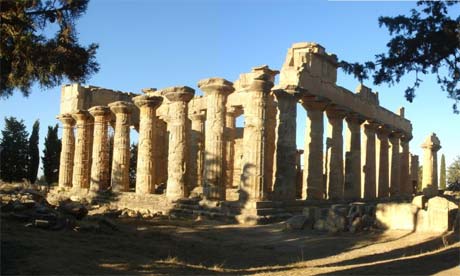
"On Monday, in the ruins of the Green Mountain's ancient city of Cyrene, Gadafy's second eldest son, the bookish Saif al-Islam Gadafy, nervously announced the ambitious scheme to a crowd of VIPs, local dignitaries and journalists. "We must build our own societies in a way that minimises the release of greenhouse gases, while allowing every citizen to share in the social and economic benefits of well-planned development," he said in halting English, before signing the extremely important-sounding Cyrene Declaration.
The declaration basically says everything the world would want to hear: sustainable development; archaeological conservation; eco-tourism; renewable energy; environmentally responsible town planning; micro-banking; education; biofuels; even production of "the finest quality organic food and drink". In essence, it was a declaration that Libya are now more interested in saving the planet than bankrolling terrorists, and that one day soon the Green Mountain region would be a very nice place to come on holiday - a sort of cross between St Tropez, the garden of Eden, and Waitrose.
To achieve these daunting ambitions, Saif al-Islam has created the Green Mountain Conservation and Development Authority, a curious coalition of international experts in green technology, conservation, agriculture, architecture and whatever else, with responsibility for a 5,500 sq km area littered with Greek, Roman and Byzantine ruins and with 220km of largely unspoilt coast. And leading the whole plan is Britain's ubiquitous architectural troubleshooter, Norman Foster.
To give the bewildered onlookers a sense of Gadafy Jnr's vision, Foster and Partners had put up a small exhibition within the ruins, with diagrams and photographs and models, many of which showcased previous Foster projects such as the Carré d'Art in Nimes, their wind turbine design from the early 1990s, and even the Reichstag in Berlin. Presumably, this was to demonstrate that the architect's high-tech oeuvre worked well against more classical styles, but onlookers could be forgiven for wondering if Foster wasn't thinking of putting a giant glass dome over Cyrene's Temple of Zeus.
Foster and Partners had only been on the project six weeks or so, admits Norman's right-hand man, Spencer de Grey. "These are just illustrations of the potential and aims of ambition of the big picture," he says. "We met [Saif al-Islam] three or four years ago in London, and Norman and I made a visit here after that. This decision is more recent, but we were then asked to help in his vision, with a regional masterplan strategy and some pilot projects. I think sustainability is absolutely at the root of all of this. It is a wonderful opportunity for Libya to leapfrog everybody and show the world how ecological tourism can be integrated with the local community."
The pilot projects turn out to be three luxury hotels - though they do at least adhere to green design principles. The Cyrene Grand Hotel, close to the ruined city, will be built on the footprint of an existing hotel built by the occupying Italians during the 1930s (and later bombed by the British). The other two are spa and holiday resorts in the hills. The designs are purely preliminary, but Foster's people are taking pains to tick all the sustainable design boxes: utilising natural ventilation, passive solar strategies, natural local materials and minimal impact on the landscape. One of the resorts is set into the rim of a dramatic canyon, for example, and adopts a camouflage strategy, with low-rise stone-clad buildings nestled among the scrubby vegetation. Even the windows will be deeply recessed so that they do not glint in the sun. Guests will still, though, have a fine view from their cliff-edge infinity pools, if the brochure is anything to go by."
No comments:
Post a Comment